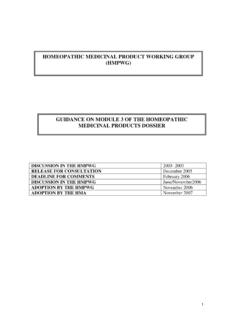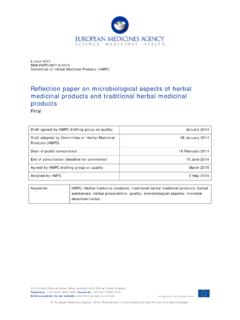Transcription of Clinical Investigation of Medicinal Products for the ...
1 30 Churchill Place Canary Wharf London E14 5EU United Kingdom An agency of the European Union Telephone +44 (0)20 3660 6000 Facsimile +44 (0)20 3660 5555 Send a question via our website European Medicines Agency, 2018. Reproduction is authorised provided the source is acknowledged. 14 December 2017 CPMP/EWP/556/95 Rev. 2 Committee for Medicinal Products for Human Use (CHMP) Guideline on Clinical Investigation of Medicinal Products for the treatment of rheumatoid arthritis Draft Agreed by Rheumatology-Immunology Working Party (RIWP) December 2011 Adoption by CHMP for release for consultation 5 December 2011 End of consultation (deadline for comments) 05 June 2012 Agreed by Rheumatology-Immunology Working Party (RIWP) March 2015 Adoption by CHMP 20 March 2015 Start of public consultation 4 June 2015 End of consultation (deadline for comments) 29 November 2015 Agreed by Rheumatology-Immunology Working Party (RIWP)
2 24 November 2017 Adoption by CHMP 14 December 2017 Date of coming into effect 01 July 2018 This guideline replaces the Points to consider on the Clinical Investigation of Medicinal Products other than NSAIDS in rheumatoid arthritis (CPMP/EWP/556/95 REV. 1) Keywords Rheumatoid arthritis, Disease Modifying Anti-Rheumatic Drugs, Clinical development, CHMP, EMA, guideline Guideline on Clinical Investigation of Medicinal Products for the treatment of rheumatoid arthritis CPMP/EWP/556/95 Rev. 2 Page 2/16 Guideline on Clinical Investigation of Medicinal Products for the treatment of rheumatoid arthritis Table of contents List of abbreviations .. 3 Executive summary .. 4 1. Introduction (Background) .. 4 2. 5 3. Legal basis and relevant guidelines .. 5 4.
3 Criteria and Standards for Patient selection .. 6 5. Possible indications/treatment goals .. 6 6. Assessment of efficacy .. 6 Primary endpoints .. 7 Secondary endpoints .. 8 Imaging .. 8 7. Strategy and design of Clinical trials .. 9 Pharmacokinetics .. 9 Dose-Response studies .. 9 Interactions .. 9 Therapeutic confirmatory studies .. 10 Study population .. 10 Study design .. 10 Specific study designs .. 11 8. Clinical safety evaluation .. 13 Specific effects .. 13 Long-term effects .. 14 Extent of population exposure to assess Clinical safety .. 14 9. Studies in special populations .. 14 Studies in elderly patients .. 14 Studies in paediatric patients .. 14 10. Other .. 14 References .. 16 Guideline on Clinical Investigation of Medicinal Products for the treatment of rheumatoid arthritis CPMP/EWP/556/95 Rev.
4 2 Page 3/16 List of abbreviations ACPA Anti-citrullinated peptide/protein antibodies ACR American College of Rheumatology CCP Anti-cyclic citrullinated protein/peptide CDAI Clinical Disease Activity Index CHMP Committee for Human Medicinal Products CRP C-reactive protein DAS Disease activity score DMARD Disease-modifying anti-rheumatic drug EMA European Medicines Agency ESR Erythrocyte Sedimentation Rate EU European Union EULAR European League against Rheumatism HAQ-DI Health Assessment Questionnaire- Disability Index ICH International Conference on Harmonization of Technical Requirements for Registration of Pharmaceuticals for Human Use JIA Juvenile idiopathic arthritis LDA Low Disease Activity MRI Magnetic Resonance Imaging MTX Methotrexate PD Pharmacodynamic RA Rheumatoid arthritis RAMRIS Rheumatoid Arthritis Magnetic Resonance Imaging Score RF Rheumatoid factor SDAI Simplified Disease Activity Index SF-36 Short-Form 36-item Health Survey SmPC Summary of Medicinal product Characteristics TNF- Tumor necrosis factor-alpha US Ultrasound VAS Visual analogue scale Guideline on Clinical Investigation of Medicinal Products for the treatment of rheumatoid arthritis CPMP/EWP/556/95 Rev.
5 2 Page 4/16 Executive summary This document is intended to provide guidance on the Clinical evaluation of Medicinal Products in the treatment of rheumatoid arthritis (RA). RA is a chronic systemic inflammatory disease of synovial joints and other organ systems. If left untreated, it causes joint destruction, deformity and functional impairment. Treatment options include synthetic and biological disease-modifying anti-rheumatic drugs (DMARDs), and glucocorticosteroids. This document is a revision of the Points to Consider adopted in November 2003. Pharmacological therapy has advanced for RA in the last decade. Therapeutic strategies employing more intensive intervention in early disease, often using combinations of non-biologic and biologic DMARDs, have shown a faster onset of action and more profound Clinical responses than traditional approaches.
6 Treat-to-target strategies are now employed, meaning that the optimum treatment goal is remission, or at least low disease activity in patients irresponsive to earlier treatments. Until the desired treatment target is reached, drug therapy should be adjusted at least every 3 to 6 months. In addition, new classification criteria for rheumatoid arthritis have been developed and validated by the ACR-EULAR, which allows for earlier DMARD use. These advancements require modified recommendations for the development of these therapies. This has led to new endpoints reflecting treatment targets of remission or low-disease activity at earlier time points, in place of the previous primary endpoint of meeting ACR20 improvement criteria at 6 months. Furthermore, a distinction is currently made in this Guideline between trials in DMARD-na ve RA patients or in patients who have had an inadequate response (IR) to prior therapy with DMARDs.
7 Recommendations are also introduced on how to measure the prevention of structural bone damage. In addition, increasing knowledge of the risk associated with DMARDs treatment has been gained from trials and registries. The key elements for the assessment of safety issues which should be considered when developing new pharmacological treatments have been updated accordingly. 1. Introduction (Background) Rheumatoid arthritis (RA) is an autoimmune disease, involving accumulation and activation of several cell subsets: T cells with release of T-cell derived cytokines; B cells with subsequent autoantibody responses, and macrophage- and fibroblast-like cells which produce large amounts of pro-inflammatory cytokines. However, the exact pathogenesis of RA is still unknown.
8 The resulting hyperplastic synovial membrane, in conjunction with osteoclast activation, leads to adjacent cartilage and bone degradation. Blood levels of C-reactive protein (CRP), rheumatoid factor (RF) and anti-citrullinated peptide/protein antibodies (ACPA) are increased in many patients. The main Clinical symptoms arise from a chronic fluctuating inflammation of the joints which, if uncontrolled, leads to progressive joint destruction resulting in deformities and disability. The disease can be accompanied by systemic manifestations ( vasculitis, nodules). The prevalence of RA is in the order of of the population. It occurs about two to three times more commonly in women than in men, although this gender difference disappears in later life as the overall prevalence increases.
9 Onset is maximal in the fifth-sixth decades. Genetic and ethnic influences on the incidence and disease expression have been identified. Smoking particularly in patients with HLA-DRB1 shared epitope alleles may influence the development and outcome of RA. Guideline on Clinical Investigation of Medicinal Products for the treatment of rheumatoid arthritis CPMP/EWP/556/95 Rev. 2 Page 5/16 Features of the disease that are amenable to improvement by existing pharmaceutical treatments comprise inflammation and joint damage, and Clinical features such as pain and physical disability. The treatment paradigm has changed significantly I n the last decade since more successful treatment options have become available. There has been a shift towards more aggressive treatment in an earlier disease phase, with the aim to achieve tight control of disease activity (treatment to target), in order to prevent joint damage.
10 ACR-EULAR 2010 classification criteria for RA were specifically developed to classify RA and allow treatment with DMARDs in an earlier disease phase than before, with the intention of altering the prognosis of RA with early intervention. Further development of assessment instruments ( disease activity status and response scores, remission criteria) have been elaborated in recent years. In addition, EULAR recommendations for management of rheumatoid arthritis were updated in 2013 and 2016, with prominence given to a treat to target approach to aim for remission or low disease activity in all patients. Adverse effects associated with current anti-rheumatic medication occur frequently. Special measures of surveillance and follow-up are often required depending on the specific characteristic of the drug or the combination used, as with MTX-containing regimes ( blood cell count, liver function, infections, malignancies).

















